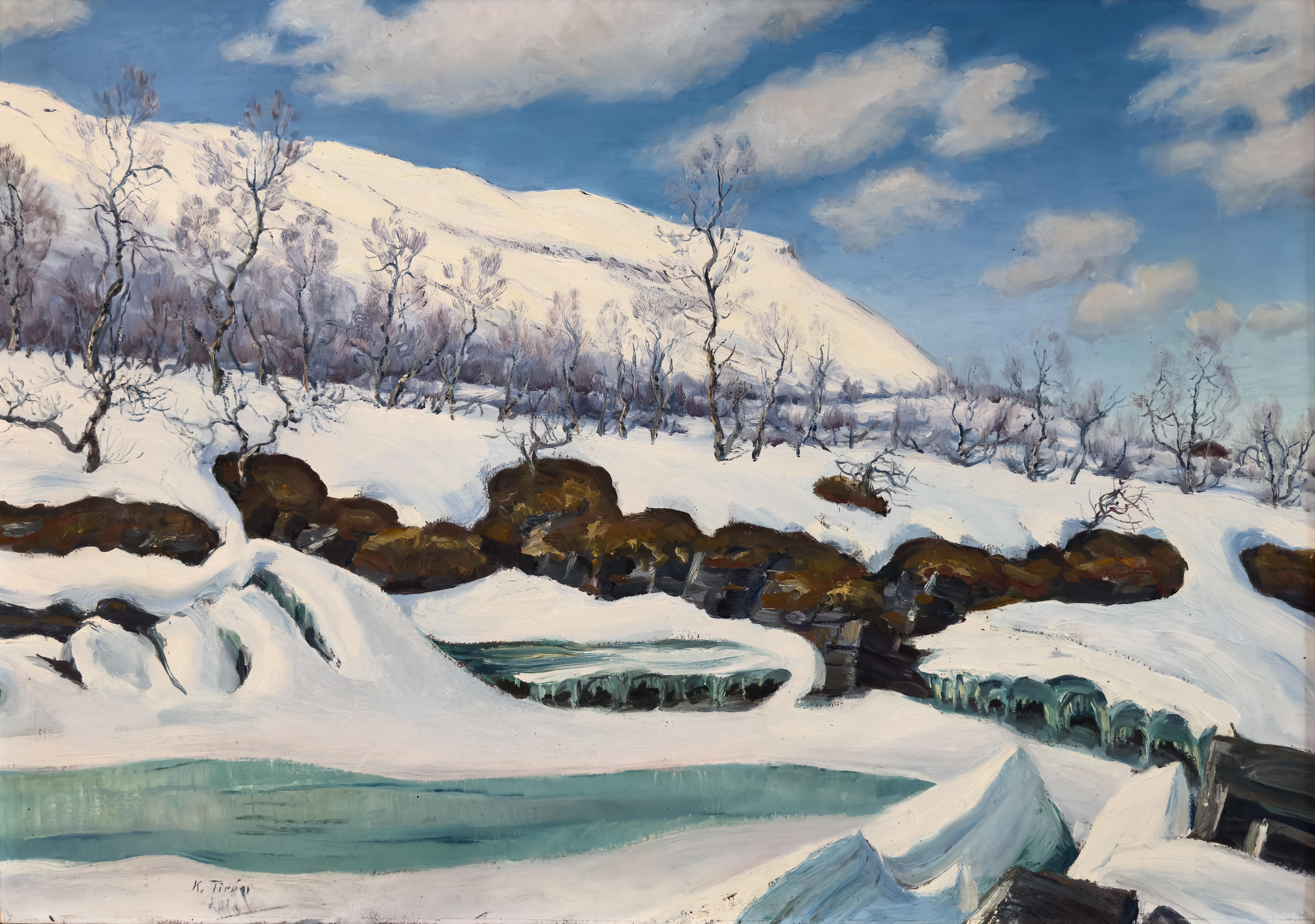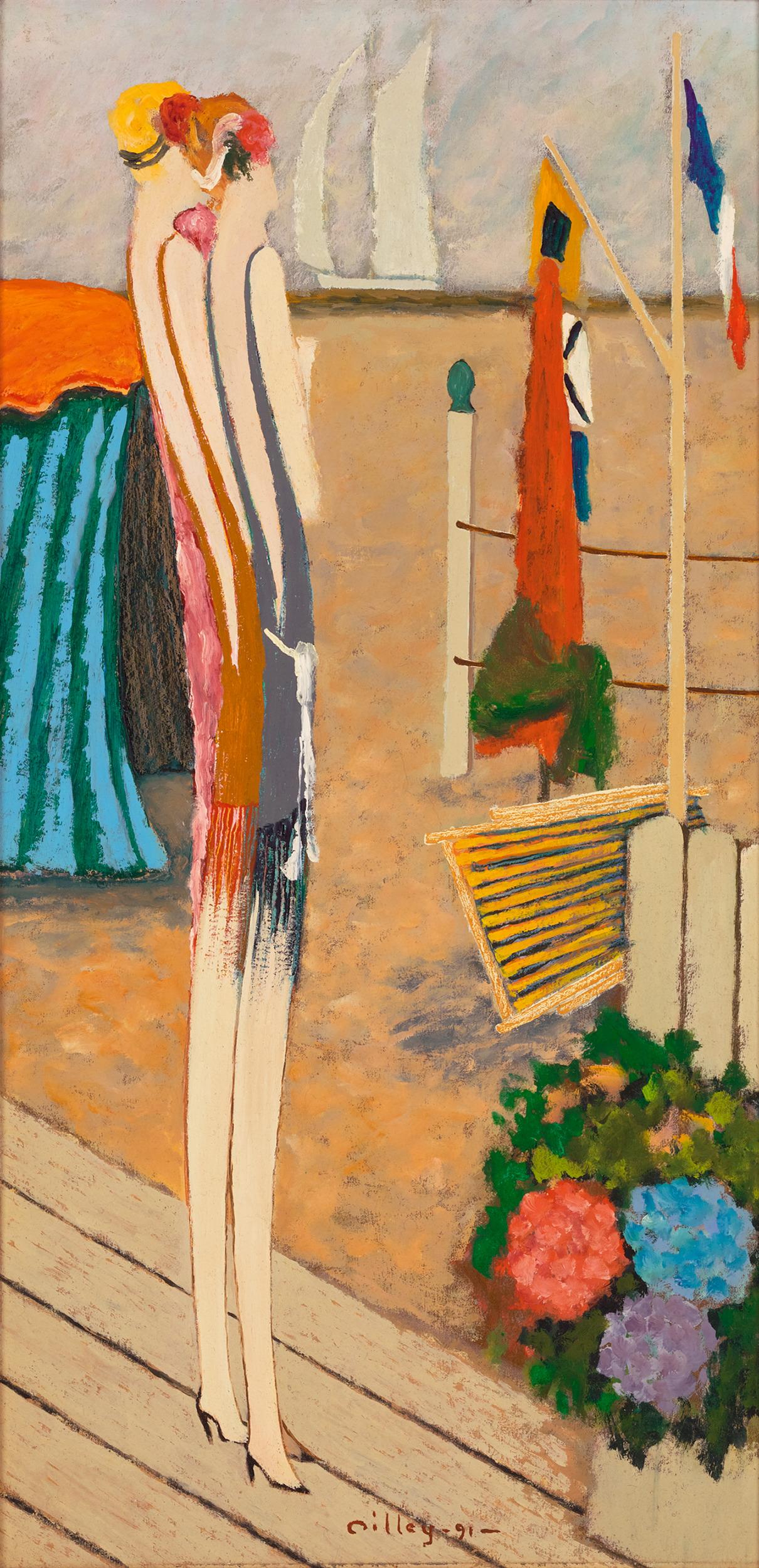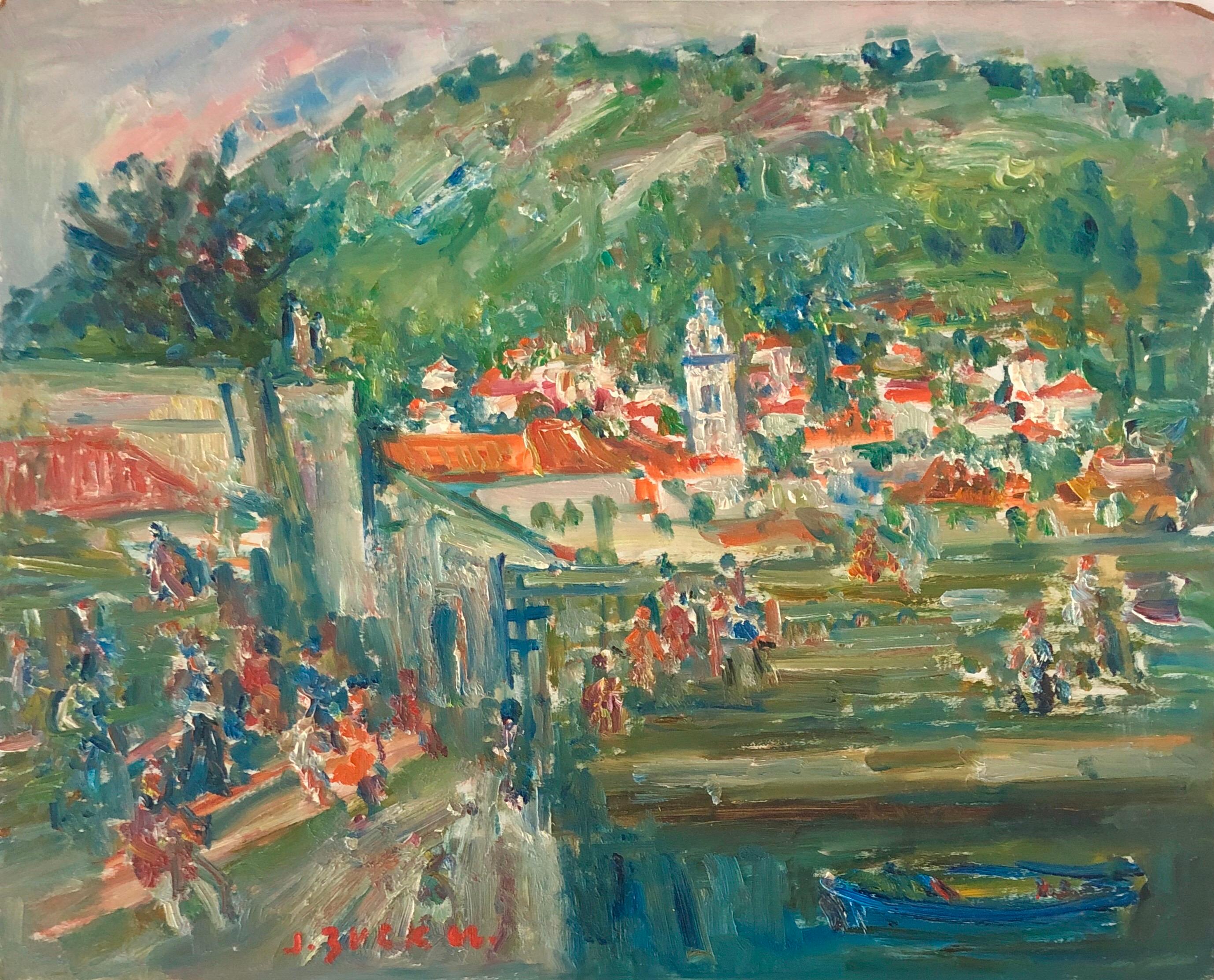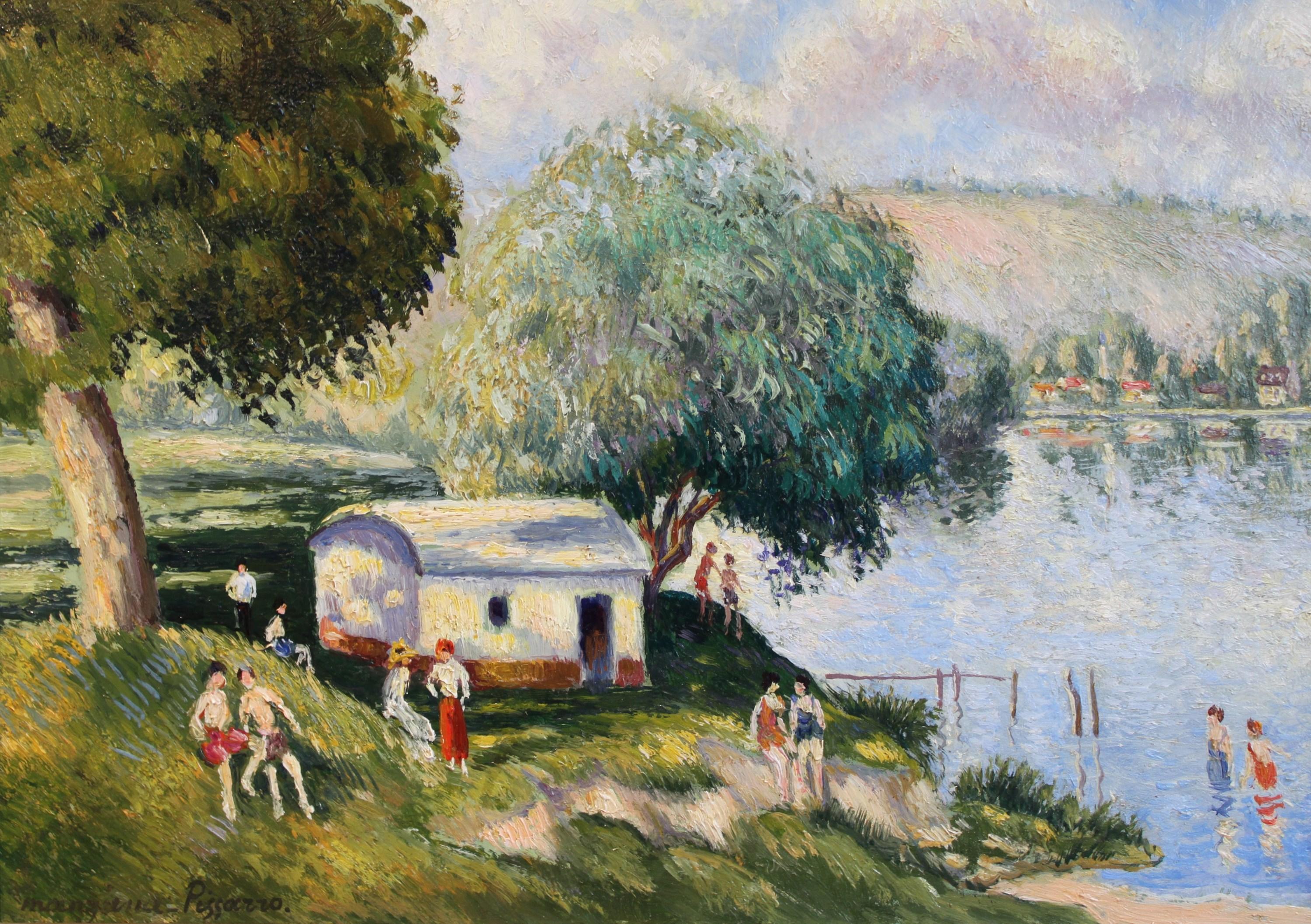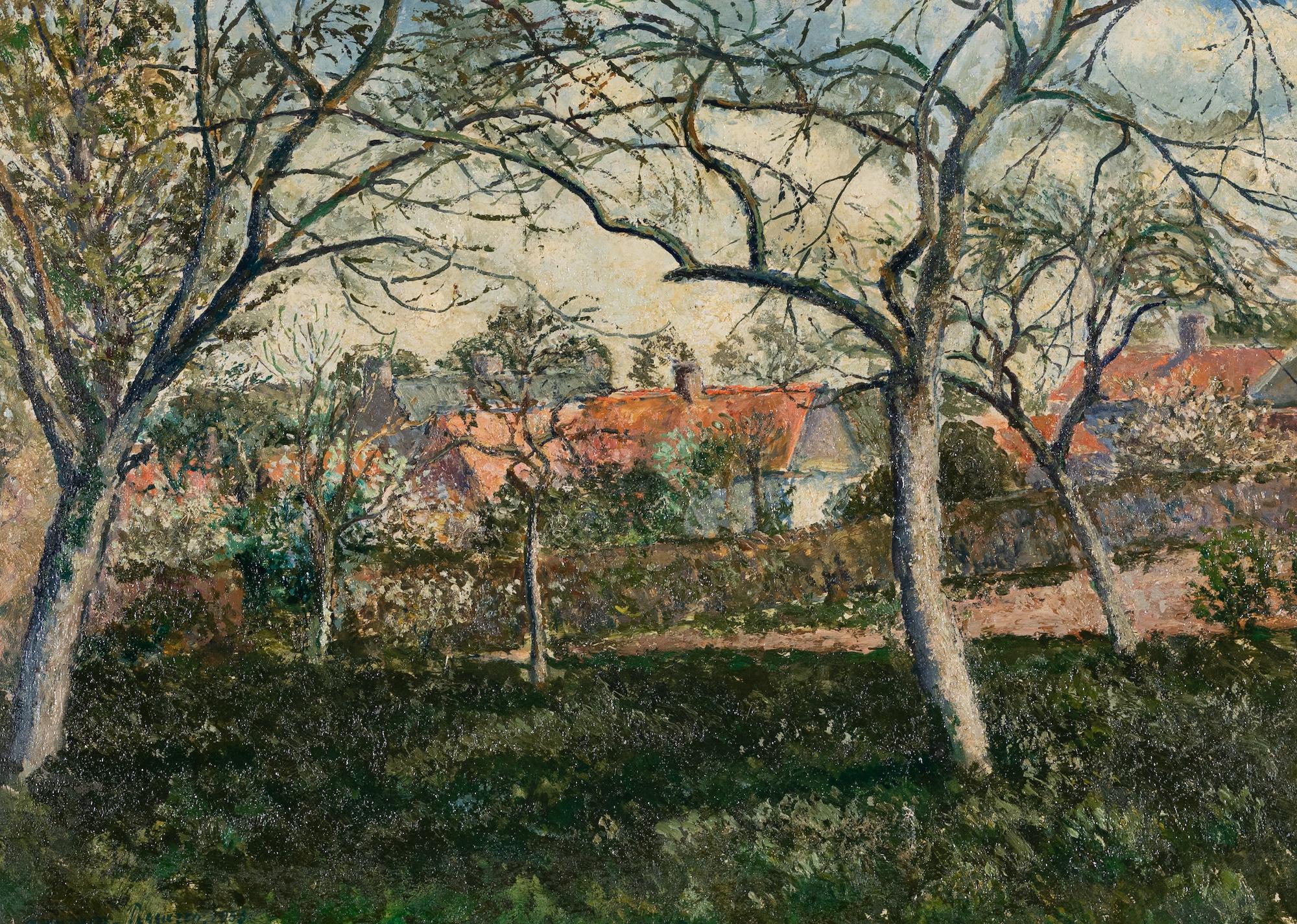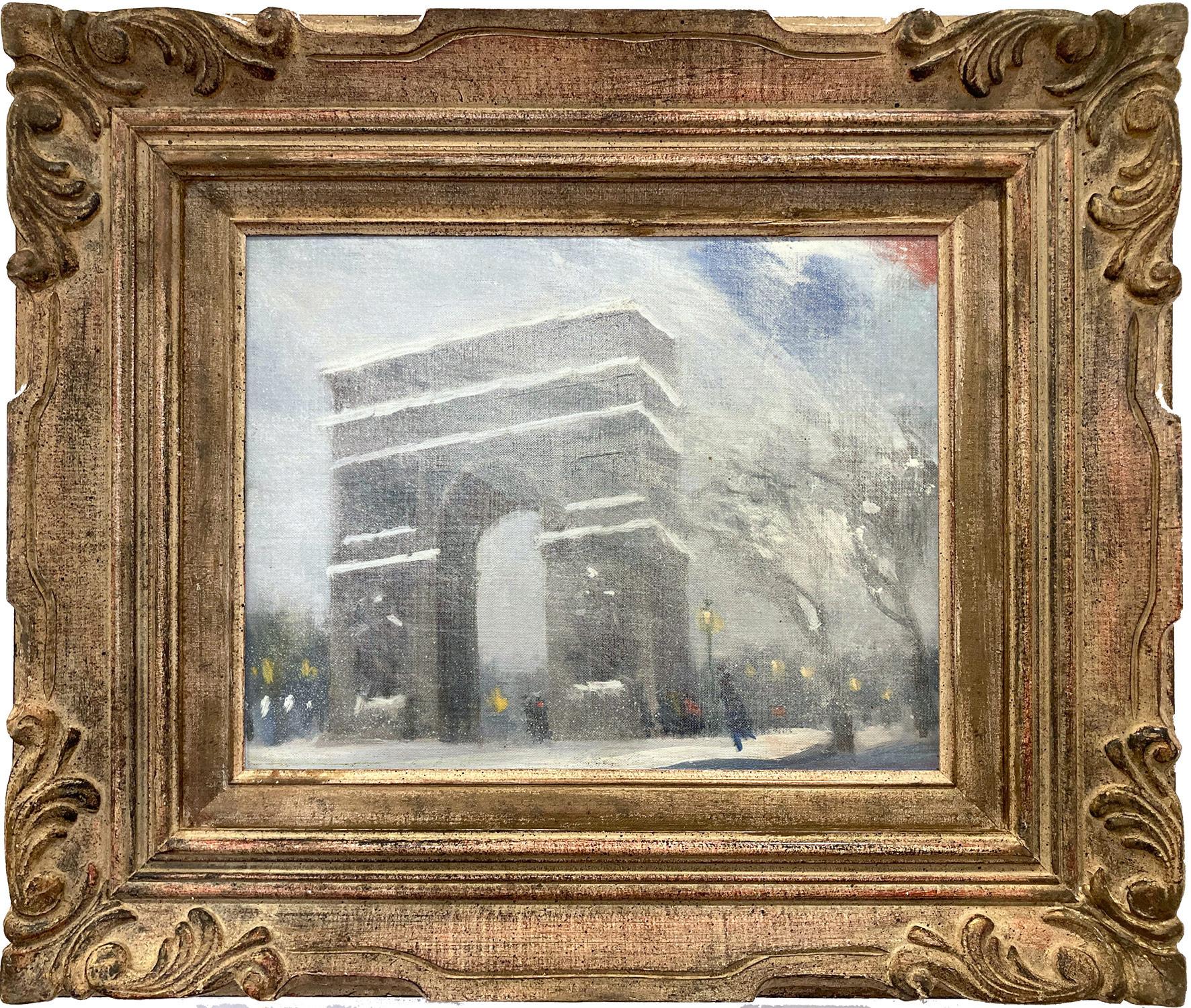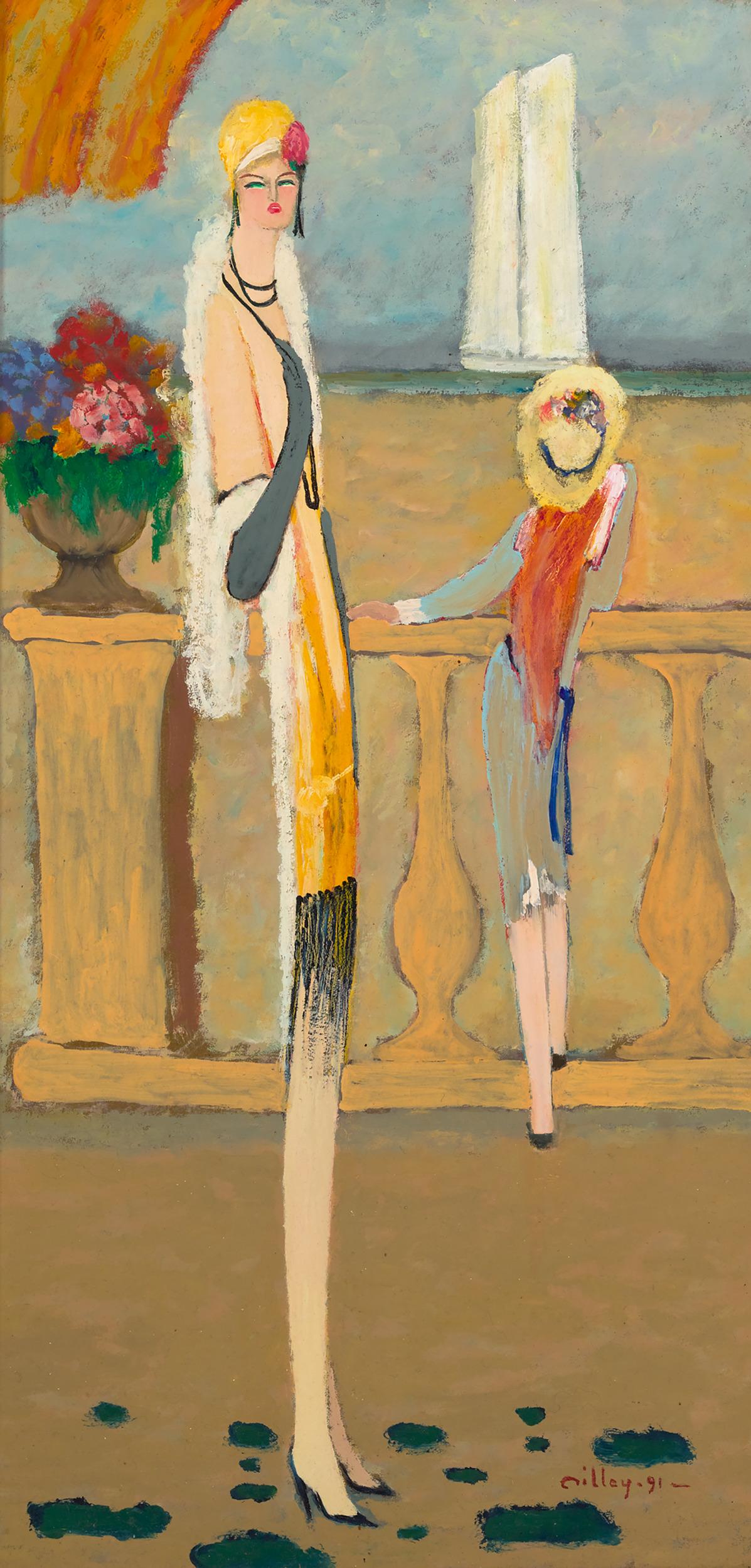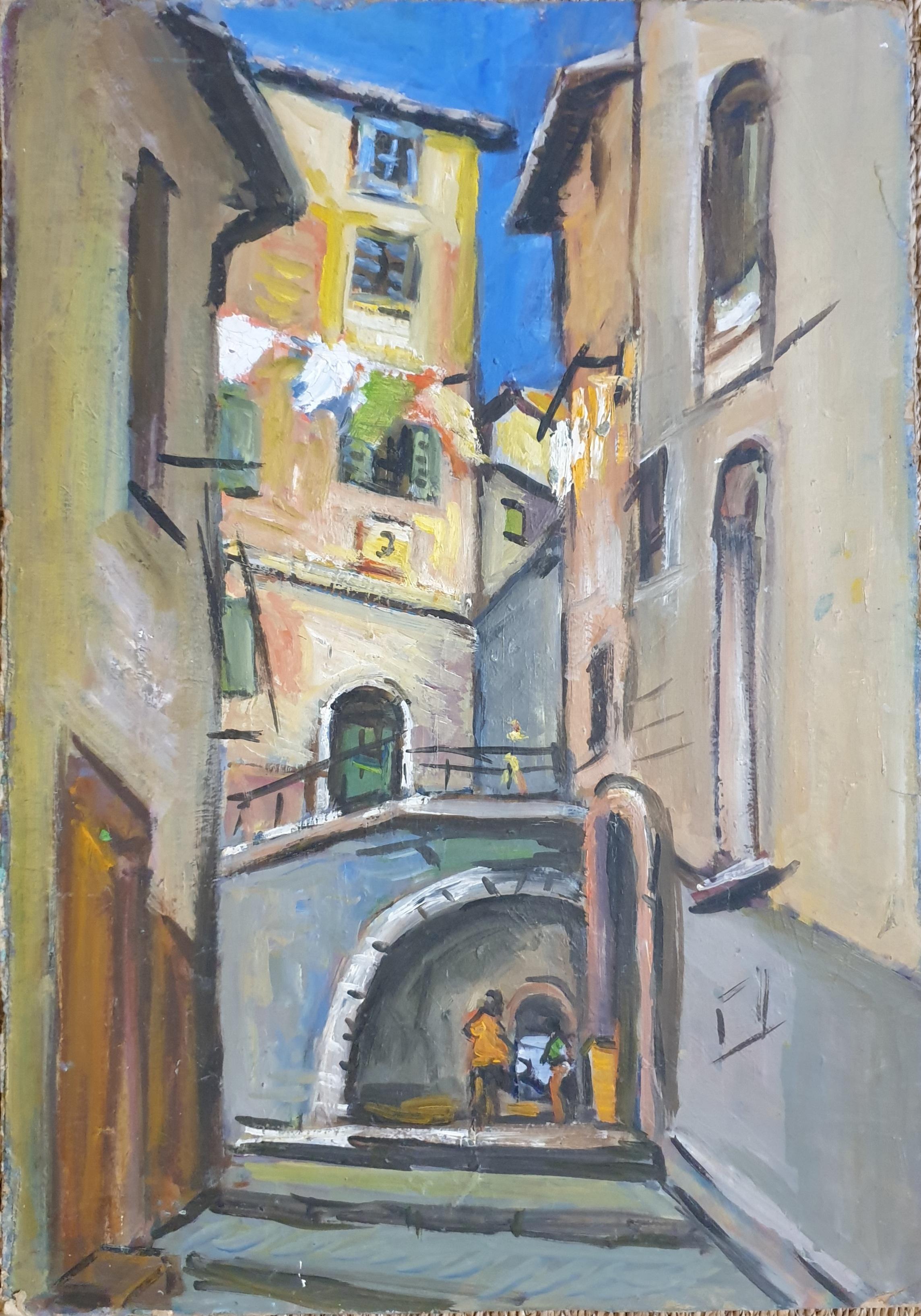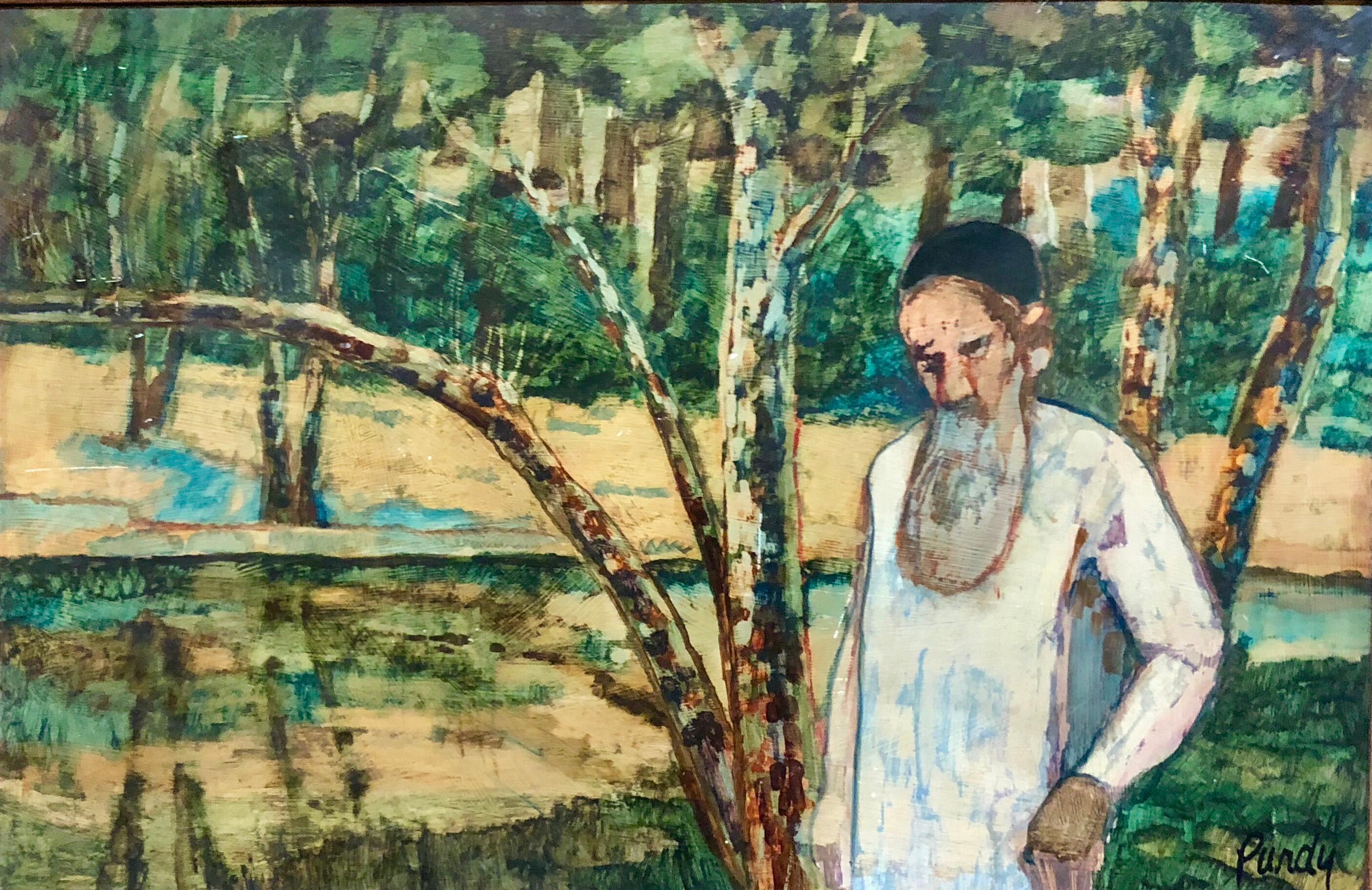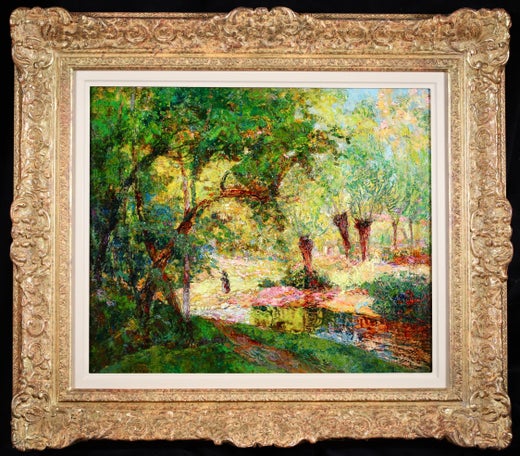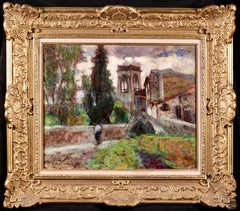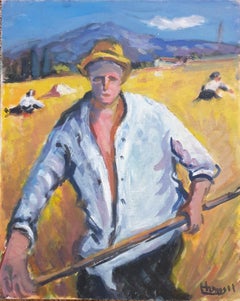
Courtyard - Post Impressionist Oil, Figure in Landscape by Victor Charreton
View Similar Items
Victor CharretonCourtyard - Post Impressionist Oil, Figure in Landscape by Victor Charretonc.1920
c.1920
About the Item
- Creator:Victor Charreton (1864-1937, French)
- Creation Year:c.1920
- Dimensions:Height: 21 in (53.34 cm)Width: 24 in (60.96 cm)
- Medium:
- Movement & Style:
- Period:
- Condition:Very good original condition.
- Gallery Location:Marlow, GB
- Reference Number:Seller: LFA06131stDibs: LU41539193712
Victor Charreton
Victor Charreton was the son of a surveyor. He spent his childhood in Chaumont and went to school in Bourgoin. In 1885 he began studying law at Grenoble University and in 1892 became a solicitor at the Lyons Court of Appeal. He had been creating paintings since childhood and was given advice by Ernest Hareux (he did not merely read his treatise on painting, which was highly regarded at the time) and also later by Louis Japy.
In 1902 Charreton gave up his legal career to devote his time to painting. The same year he moved to Paris. Every summer, from 1912 onwards, he would spend time at his house in St-Amant-Tallende near Clermont-Ferrand, where his wife came from. He also traveled abroad — to Algeria in 1905, to Spain and England in 1912 and to Belgium and Holland in 1913 — visiting numerous museums along the way. He also visited Corsica and Germany. He led the life of an aesthete and man of culture and was a lover of poetry and music. In 1914 he was made a Chevalier of the Légion d'Honneur.
Charreton was a landscape artist in the Lyons tradition with a love of sensual impasto. In his works he sought to capture fleeting, momentary effects, like those achieved by the Impressionists: effects at different times of day and in different seasons, such as dusk and snow. As a young man he painted the environs of Bourgoin, but his marriage in 1893 took him to Auvergne where he painted the characteristic landscapes of the region. Landscapes of Auvergne make up approximately two-thirds of Charreton’s output. What became known as the School of Murols, named after a village in Auvergne, was principally formed around him between 1910 and 1925. Skilled in capturing minute changes in the weather, he was also adept at capturing the spirit of new places.
Beside his native Dauphiné and his adopted Auvergne, Charreton was also charmed by the landscapes of the Île-de-France and Paris — Montmartre, the Jardin du Luxembourg and the Parc Montsouris — and also Provence, Creuse and Brittany. However, no trace has been found of his trips abroad. It would be a misjudgment to think that Charreton only painted pretty picture-postcard scenes in the regions he visited; on the contrary, he would seek out the intimist qualities of a place, choosing perhaps a quiet hamlet, with a humble bridge over an anonymous stretch of water, or an ordinary tree outside a tumbledown house.
Charreton would paint blazing autumn landscapes, with a sumptuous color palette, but also favored snowy scenes, their exact chromatic opposite. At the start of his career he would paint dusky scenes and contre-jours in halftones and misty sunsets. As Charreton’s artistic development progressed, he attached more and more importance to light and color. In this respect his work follows on from that of Ravier and, like Guillaumin, it is almost a precursor to Fauvism, or alternatively can be regarded as complicit with it, like the work of Maurice Marinot. Charreton’s brushwork evolved in tandem with his use of color, which became ever more vibrant; for example his fondness for purple hues and later his striking color contrasts. His brushwork became more conspicuous and he would suppress the insignificant details in order to bring out the forms that made up the general composition.
Among art historians Charreton is not ranked alongside the innovators who succeeded the Impressionists, like Gauguin, Seurat, Van Gogh or Cézanne. Older than Matisse, who was himself already by far the eldest of the Fauves, Charreton stopped short of what he considered to be their excesses. He placed himself at the crossroads between two centuries: the end of the century of Impressionism and the start of the leaps made by Fauvism. His life and the major themes in his work are evidence of this, but he decided to be a regional painter; as such, his talent and qualities are clearer than they may otherwise have been if he had chosen a more ambitious career. Beside his painting, he also wrote a play in three acts entitled The Montrouge Well (Le Puits de Montrouge), which was performed in Bourgoin in December 1883.
Charreton made his debut at the Lyons Salon in 1894 with Morning in Montpeyroux. That same year he began exhibiting in Paris at the Salon of the Société des Artistes Français, showing October Evening. He was awarded an honorable mention in 1910, a silver medal in 1912, a gold medal in 1913 and a commendation outside the competition in 1914. He also became a member of the committee and the jury and exhibited there until his death.
Charreton took part in collective exhibitions in France — in Toulouse, Clermont-Ferrand, Roubaix and Bordeaux — and abroad, in New York, Geneva and Barcelona. In 1915 he held a solo exhibition at the Galerie Georges Petit in Paris. He exhibited in New York, Toledo, Pittsburgh, Cleveland and Japan. In 1931 Charreton inaugurated the Musée de Bourgoin by donating around 20 works; the museum then changed its name to the Musée Victor Charreton. He was also one of the founders and general secretary of the Salon d'Automne. In 1972 the Musée de Montmartre organized a posthumous retrospective exhibition of his work; in 1987 and 1989 two more were held in a Paris gallery; then in 2003 the Musée de Bourgoin-Jallieu (in Isère) held in exhibition entitled “Victor Charreton: The Public Collections.”
Find original Victor Charreton art on 1stDibs.
(Biography provided by Leighton Fine Art)
- Promenade au Village - Post Impressionist Oil, Landscape by Victor CharretonBy Victor CharretonLocated in Marlow, BuckinghamshireStunning signed figure in landscape oil on board circa 1920 by sought after French Post-Impressionist painter Victor Charreton. The piece depicts a man walking up a hilly path past t...Category
1920s Post-Impressionist Landscape Paintings
MaterialsOil, Board
- Fillette a la pousette - Figurative Post Impressionist Oil, by Victor CharretonBy Victor CharretonLocated in Marlow, BuckinghamshireSigned figure in landscape oil on board circa 1910 by sought after French post impressionist painter Victor Charreton. This charming piece depicts a young girl in a pink dress and ha...Category
1910s Post-Impressionist Figurative Paintings
MaterialsOil, Board
- Figures in the Forest - Post Impressionist Landscape Oil by Paul GernezBy Paul-Élie GernezLocated in Marlow, BuckinghamshireSigned post impressionist landscape oil on board circa 1914 by French painter Paul Elie Gernez. The work depicts figures walking in the shade of trees...Category
1910s Post-Impressionist Landscape Paintings
MaterialsBoard, Oil
- Snowy Village - Post Impressionist Oil, Winter Landscape by Victor CharretonBy Victor CharretonLocated in Marlow, BuckinghamshireA wonderful oil on board circa 1920 by sought after French post impressionist painter Victor Charreton, who was known as the painter of colours. The piece depicts a figure walking th...Category
1920s Post-Impressionist Landscape Paintings
MaterialsOil, Board
- Les Collines du Dauphine - Post Impressionist Oil, Landscape by Victor CharretonBy Victor CharretonLocated in Marlow, BuckinghamshireBeautiful signed oil on board landscape circa 1920 by sought after post impressionist painter Victor Charreton. The piece depicts a figure walking through green rolling fields with h...Category
1920s Post-Impressionist Landscape Paintings
MaterialsOil, Board
- Figure before a Church - Post Impressionist Landscape Oil by Victor CharretonBy Victor CharretonLocated in Marlow, BuckinghamshireSigned figure in landscape oil on board circa 1920 by sought after French Post-Impressionist painter Victor Charreton. The piece depicts a lone figure walking through a wooded area i...Category
1920s Post-Impressionist Landscape Paintings
MaterialsOil, Board
- "Sunday Spring Cleaning" Point Pleasant Bucks County Landscape Oil PaintingLocated in New York, NYPost-Impressionist summer pastoral scene of a house in the field with chickens in the garden and figure. Taking place in Bucks County, PA. Willett has portrayed this piece in a most ...Category
20th Century Post-Impressionist Landscape Paintings
MaterialsBoard, Oil
- Le Faucheur, Bringing in the Harvest. French Fauvist Mid-Century Oil on Board.Located in Cotignac, FRFrench Mid 20th Century oil on canvas board. Fauvist view of a young man, a faucheur, bringing in the harvest, probably painted near Nice in the South of France by Hyppolite Roger...Category
Mid-20th Century Fauvist Figurative Paintings
MaterialsOil, Acrylic, Board
- Vårvinter II (Winter, Early Spring II), Oil on Board, C. 1909Located in Stockholm, SEThe painting "Vårvinter II," believed to have been painted around 1909 by the Swedish artist Karl Tirén, is a remarkable representation of a landscape in the cusp of the seasonal tra...Category
Early 1900s Post-Impressionist Landscape Paintings
MaterialsBoard, Oil
- Élégantes À Deauville By Ramon DilleyLocated in New Orleans, LARamon Dilley 1933 - Spanish Élégantes à Deauville Signed “Dilley 91” (lower right) Signed and titled “Ramon Dilley / Elegantes a Deauville” (en verso) Oil on board laid on canvas ...Category
20th Century Post-Impressionist Figurative Paintings
MaterialsCanvas, Oil, Board
- French Riviera Harbor Scene Oil Painting Ecole D'Paris, WPA, Bezalel ArtistBy Jacques ZuckerLocated in Surfside, FLGenre: Post Impressionist Subject: Landscape Medium: Oil Surface: board Country: France Dimensions: 13" x 16" Jacques Zucker was born in 1900 in Radom, Poland. He was a notably famous Jewish American artist mostly known for his expressionist figure paintings. In his young years he traveled to Palestine to study fine arts at the Bezalel Art School in Jerusalem. In 1917 he joined the British Royal Fuesiliers under the leadership of General Allenby to liberate Palestine from the Turks. After the first World War he settled in Paris, where he continued his studies at Académie Julian and Academie Colarossi. He then emigrated to the United States in 1922 and continued his art studies at the National Academy of Design. He supported himself by designing jewelry. In 1925 he returned to Paris and studied at the Academie de la Grande Chaumier et Colarossi. During the Depression he worked for the WPA. From 1928 he took part in the Paris Salons: Autumn and the Tuileries. His works are expressionistic variations in the type of the Ecole de Paris. As a protégé of both Chaim Soutine and Renoir, hints of their style can be observed in much of his own work. Zucker’s style, that may have been influenced from the art of artists such as Marc Chagall, took pride in being an “internationalist”, standing the art of painting in its highest expression is universal no matter where the canvas was created. People who respond to quality in art will understand the beauty and meaning, in their own land or in a foreign land, this was his main idea behind his artworks that was exhibited in numerous solo show in leading galleries and museums in New York, Paris, Tel Aviv, and other art centers. Claude Roger-Marx of Figaro Litteraire, dean of French art critics, write a comprehensive study of Zucker’s illustrated with 135 color and black and white plates. He traveled widely, including Italy, Spain, Portugal, Mexico and Israel. From then on Zucker lived alternately in New York and Paris, maintaining homes in both places, and spent considerable time painting in Mexico, Portugal, Greece, and Israel. Zucker's post-impressionist works including town and landscapes, still-lives, and portraits, are part of an array of permanent installments in numerous museums and private collections in Tel Aviv, including the Joseph Hirschorn collection in Washington, D. C., the Museum of Modern Art in Paris, and the Bezalel Art Museum in Jerusalem. In 1947 he settled in Arcueil near Paris. Zucker died in 1981 in New York. The School of Paris, Ecole de Paris, was not a single art movement or institution, but refers to the importance of Paris as a center of Western art in the early decades of the 20th century. Between 1900 and 1940 the city drew artists from all over the world and became a centre for artistic activity. School of Paris was used to describe this loose community, particularly of non-French artists, centered in the cafes, salons and shared workspaces and galleries of Montparnasse. Before World War I, a group of expatriates in Paris created art in the styles of Post-Impressionism, Cubism and Fauvism. The group included artists like Pablo Picasso, Marc Chagall, Amedeo Modigliani and Piet Mondrian. Associated French artists included Pierre Bonnard, Henri Matisse, Jean Metzinger and Albert Gleizes. The term "School of Paris" was used in 1925 by André Warnod to refer to the many foreign-born artists who had migrated to Paris. The term soon gained currency, often as a derogatory label by critics who saw the foreign artists—many of whom were Jewish—as a threat to the purity of French art. Art critic Louis Vauxcelles, noted for coining the terms "Fauvism" and "Cubism", Waldemar George, himself a French Jew, in 1931 lamented that the School of Paris name "allows any artist to pretend he is French. it refers to French tradition but instead annihilates it. The artists working in Paris between World War I and World War II experimented with various styles including Cubism, Orphism, Surrealism and Dada. Foreign and French artists working in Paris included Jean Arp, Joan Miro, Constantin Brancusi, Raoul Dufy, Tsuguharu Foujita, artists from Belarus like Michel Kikoine, Pinchus Kremegne, and Jacques Lipchitz, the Polish artist Marek Szwarc and others such as Russian-born prince Alexis Arapoff. A significant subset, the Jewish artists, came to be known as the Jewish School of Paris or the School of Montparnasse. The core members were almost all Jews, and the resentment expressed toward them by French critics in the 1930s was unquestionably fueled by anti-Semitism. Jewish members of the group included Emmanuel Mané-Katz, Chaim Soutine, Adolphe Féder, Chagall, Moïse Kisling, Maxa Nordau and Shimshon Holzman...Category
Mid-20th Century Post-Impressionist Landscape Paintings
MaterialsBoard, Oil
- La Plage aux Andelys, oil on board by Georges Manzana Pissarro - LandscapeBy Georges Manzana PissarroLocated in London, GBLa Plage aux Andelys by Georges Manzana Pissarro (1871 - 1961) Oil on board 23.7 x 32.9 cm (9 ⅓ x 13 inches) Signed lower left, Manzana Pissarro Executed circa 1930 Provenance Priva...Category
1930s Post-Impressionist Figurative Paintings
MaterialsOil, Board


